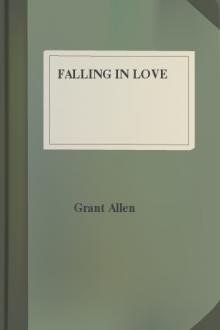Falling in Love by Grant Allen (different e readers .txt) 📕

- Author: Grant Allen
- Performer: -
Book online «Falling in Love by Grant Allen (different e readers .txt) 📕». Author Grant Allen
Clearly, this curious Australian cousin of the Mediterranean sea-horses has acquired so marvellous a resemblance to a bit of fucus in order to deceive the eyes of its ever-watchful enemies, and to become indistinguishable from the uneatable weed whose colour and form it so surprisingly imitates. Protective resemblances of the sort are extremely common among the pipe-fish family, and the reason why they should be so is no doubt sufficiently obvious at first sight to any reflecting mind—such, for example, as the intelligent reader's. Pipe-fish, as everybody knows, are far from giddy. They do not swim in the vortex of piscine dissipation. Being mostly small and defenceless creatures, lurking among the marine vegetation of the shoals and reefs, they are usually accustomed to cling for support by their snake-like tails to the stalks or leaves of those submerged forests. The omniscient schoolboy must often have watched in aquariums the habits and manners of the common sea-horses, twisted together by their long thin bodies into one inextricable mass of living matwork, or anchored firmly with a treble serpentine coil to some projecting branch of coralline or of quivering sea-wrack. Bad swimmers by nature, utterly unarmed, and wholly undefended by protective mail, the pipe-fish generally can neither fight nor run away: and therefore they depend entirely for their lives upon their peculiar skulking and lurking habits. Their one mode of defence is not to show themselves; discretion is the better part of their valour; they hide as much as possible among the thickest seaweed, and trust to Providence to escape observation.
Now, with any animals thus constituted, cowards by hereditary predilection, it must necessarily happen that the more brightly coloured or obtrusive individuals will most readily be spotted and most unceremoniously devoured by their sharp-sighted foes, the predatory fishes. On the other hand, just in proportion as any particular pipe-fish happens to display any chance resemblance in colour or appearance to the special seaweed in whose folds it lurks, to that extent will it be likely to escape detection, and to hand on its peculiarities to its future descendants. A long-continued course of the simple process thus roughly described must of necessity result at last in the elimination of all the most conspicuous pipe-fish, and the survival of all those unobtrusive and retiring individuals which in any respect happen to resemble the fucus or coralline among which they dwell. Hence, in many places, various kinds of pipe-fish exhibit an extraordinary amount of imitative likeness to the sargasso or seaweed to whose tags they cling; and in the three most highly developed Australian species the likeness becomes so ridiculously close that it is with difficulty one can persuade oneself one is really and truly looking at a fish, and not at a piece of strangely animated and locomotive fucus.
Of course, the playful pipe-fish is by no means alone in his assumption of so neat and effective a disguise. Protective resemblances of just the same sort as that thus exhibited by this extraordinary little creature are common throughout the whole range of nature; instances are to be found in abundance, not only among beasts, birds, reptiles, and fishes, but even among caterpillars, butterflies, and spiders, of species which preserve the strictest incognito. Everywhere in the world, animals and plants are perpetually masquerading in various assumed characters; and sometimes their make-up is so exceedingly good as to take in for a while not merely the uninstructed ordinary observer, but even the scientific and systematic naturalist.
A few selected instances of such successful masquerading will perhaps best serve to introduce the general principles upon which all animal mimicry ultimately depends. Indeed, naturalists of late years have been largely employed in fishing up examples from the ends of the earth and from the depths of the sea for the elucidation of this very subject. There is a certain butterfly in the islands of the Malay Archipelago (its learned name, if anybody wishes to be formally introduced, is Kallima paralekta) which always rests among dead or dry leaves, and has itself leaf-like wings, all spotted over at intervals with wee speckles to imitate the tiny spots of fungi on the foliage it resembles. The well-known stick and leaf insects from the same rich neighbourhood in like manner exactly mimic the twigs and leaves of the forest among which they lurk: some of them look for all the world like little bits of walking bamboo, while others appear in all varieties of hue, as if opening buds and full-blown leaves and pieces of yellow foliage sprinkled with the tints and moulds of decay had of a sudden raised themselves erect upon six legs, and begun incontinently to perambulate the Malayan woodlands like vegetable Frankensteins in all their glory. The larva of one such deceptive insect, observed in Nicaragua by sharp-eyed Mr. Belt, appeared at first sight like a mere fragment of the moss on which it rested, its body being all prolonged into little thread-like green filaments, precisely imitating the foliage around it. Once more, there are common flies which secure protection for themselves by growing into the counterfeit presentment of wasps or hornets, and so obtaining immunity from the attacks of birds or animals. Many of these curiously mimetic insects are banded with yellow and black in the very image of their stinging originals, and have their tails sharpened, in terrorem, into a pretended sting, to give point and verisimilitude to the deceptive resemblance. More curious still, certain South American butterflies of a perfectly inoffensive and edible family mimic in every spot and line of colour sundry other butterflies of an utterly unrelated and fundamentally dissimilar type, but of so disagreeable a taste as never to be eaten by birds or lizards. The origin of these curious resemblances I shall endeavour to explain (after Messrs. Bates and Wallace) a little farther on: for the present it is enough to observe that the extraordinary resemblances thus produced have often deceived the very elect, and have caused experienced naturalists for a time to stick some deceptive specimen of a fly among the wasps and hornets, or some masquerading cricket into the midst of a cabinet full of saw-flies or ichneumons.
Let us look briefly at the other instances of protective coloration in nature generally which lead up to these final bizarre exemplifications of the masquerading tendency.
Wherever all the world around is remarkably uniform in colour and appearance, all the animals, birds, and insects alike necessarily disguise themselves in its prevailing tint to escape observation. It does not matter in the least whether they are predatory or defenceless, the hunters or the hunted: if they are to escape destruction or starvation, as the case may be, they must assume the hue of all the rest of nature about them. In the arctic snows, for example, all animals, without exception, must needs be snow-white. The polar bear, if he were brown or black, would immediately be observed among the unvaried ice-fields by his expected prey, and could never get a chance of approaching his quarry unperceived at close quarters. On the other hand, the arctic hare must equally be dressed in a snow-white coat, or the arctic fox would too readily discover him and pounce down upon him off-hand; while, conversely, the fox himself, if red or brown, could never creep upon the unwary hare without previous detection, which would defeat his purpose. For this reason, the ptarmigan and the willow grouse become as white in winter as the vast snow-fields under which they burrow; the ermine changes his dusky summer coat for the expensive wintry suit beloved of British Themis; the snow-bunting acquires his milk-white plumage; and even the weasel assimilates himself more or less in hue to the unvarying garb of arctic nature. To be out of the fashion is there quite literally to be out of the world: no half-measures will suit the stern decree of polar biology; strict compliance with the law of winter change is absolutely necessary to success in the struggle for existence.
Now, how has this curious uniformity of dress in arctic animals been brought about? Why, simply by that unyielding principle of Nature which condemns the less adapted for ever to extinction, and exalts the better adapted to the high places of her hierarchy in their stead. The ptarmigan and the snow-buntings that look most like the snow have for ages been least likely to attract the unfavourable attention of arctic fox or prowling ermine; the fox or ermine that came most silently and most unperceived across the shifting drifts has been most likely to steal unawares upon the heedless flocks of ptarmigan and snow-bunting. In the one case protective colouring preserves the animal from himself being devoured; in the other case it enables him the more easily to devour others. And since 'Eat or be eaten' is the shrill sentence of Nature upon all animal life, the final result is the unbroken whiteness of the arctic fauna in all its developments of fur or feather.
Where the colouring of nature is absolutely uniform, as among the arctic snows or the chilly mountain tops, the colouring of the animals is uniform too. Where it is slightly diversified from point to point, as in the sands of the desert, the animals that imitate it are speckled or diversified with various soft neutral tints. All the birds, reptiles, and insects of Sahara, says Canon Tristram, copy closely the grey or isabelline colour of the boundless sands that stretch around them. Lord George Campbell, in his amusing 'Log Letters from the "Challenger,"' mentions a butterfly on the shore at Amboyna which looked exactly like a bit of the beach, until it spread its wings and fluttered away gaily to leeward. Soles and other flat-fish similarly resemble the sands or banks on which they lie, and accommodate themselves specifically to the particular colour of their special bottom. Thus the flounder imitates the muddy bars at the mouths of rivers, where he loves to half bury himself in the congenial ooze; the sole, who rather affects clean hard sand-banks, is simply sandy and speckled with grey; the plaice, who goes in by preference for a bed of mixed pebbles, has red and yellow spots scattered up and down irregularly among the brown, to look as much as possible like agates and carnelians: the brill, who hugs a still rougher ledge, has gone so far as to acquire raised lumps or tubercles on his upper surface, which make him seem like a mere bit of the shingle-strewn rock on which he reposes. In short, where the environment is most uniform the colouring follows suit: just in proportion as the environment varies from place to place, the colouring must vary in order to simulate it. There is a deep biological joy in the term 'environment'; it almost rivals the well-known consolatory properties of that sweet word 'Mesopotamia.' 'Surroundings,' perhaps, would equally well express the meaning, but then, as Mr. Wordsworth justly observes, 'the difference to me!'
Between England and the West Indies, about the time when one begins to recover from the first bout of sea-sickness, we come upon a certain sluggish tract of





Comments (0)